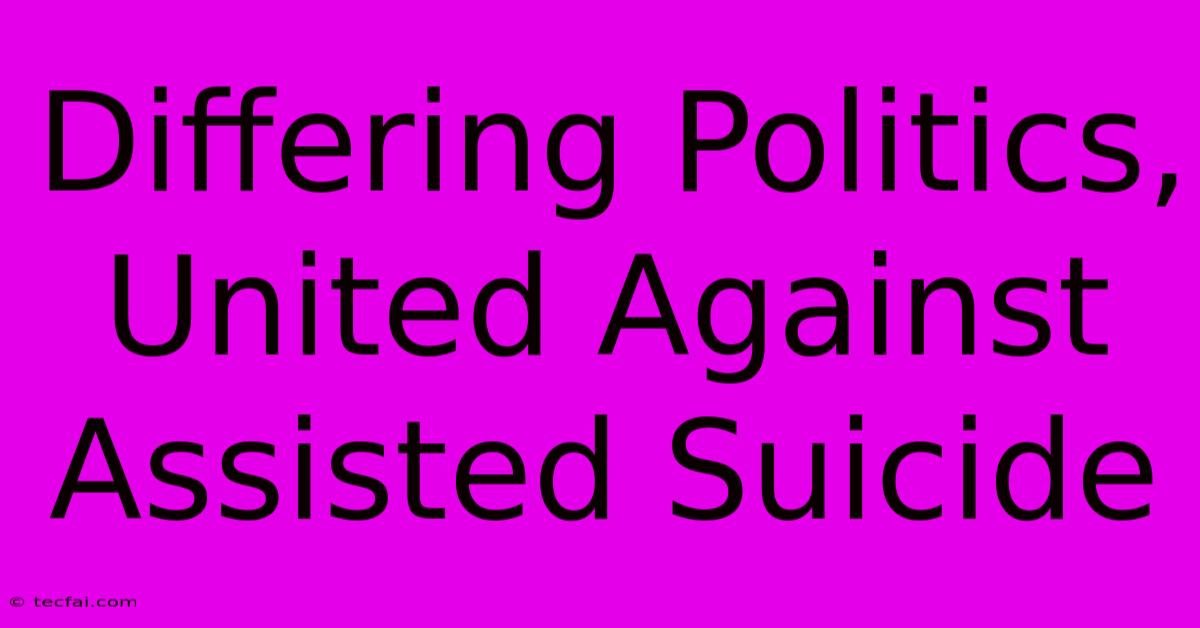Differing Politics, United Against Assisted Suicide

Discover more detailed and exciting information on our website. Click the link below to start your adventure: Visit Best Website tecfai.com. Don't miss out!
Table of Contents
Differing Politics, United Against Assisted Suicide: Finding Common Ground on a Complex Issue
The debate surrounding assisted suicide, or physician-assisted death (PAD), is often framed as a battleground of opposing political ideologies. Liberals might champion individual autonomy and the right to choose one's own death, while conservatives may emphasize the sanctity of life and the potential for abuse. However, a closer examination reveals a surprising area of common ground: a shared concern about the vulnerable and the potential for exploitation within the assisted suicide framework. While differing deeply on the fundamental principles, both sides can unite around the crucial need for robust safeguards and ethical considerations.
The Core Disagreements: A Spectrum of Beliefs
Before exploring the potential for unity, it’s important to acknowledge the deeply held beliefs that fuel the debate. Proponents of assisted suicide often highlight the importance of patient autonomy and the right to end unbearable suffering. They argue that individuals facing terminal illness, with excruciating pain and diminished quality of life, should have the agency to choose a peaceful exit. This perspective emphasizes individual liberty and self-determination as fundamental rights.
Conversely, opponents emphasize the sanctity of life, viewing it as inherently valuable and inviolable. Concerns about the potential for coercion, particularly among vulnerable populations like the elderly or those with disabilities, are central to their arguments. They also highlight the role of palliative care in managing pain and improving quality of life, suggesting that with proper support, individuals can find comfort and dignity without resorting to ending their lives. Furthermore, religious objections often play a significant role in opposing assisted suicide.
Finding Common Ground: Protecting the Vulnerable
Despite these stark differences, a critical area of convergence emerges: the need to protect vulnerable individuals from potential exploitation. Both proponents and opponents recognize that the implementation of assisted suicide legislation must include robust safeguards to prevent coercion and ensure that the choice is genuinely free and informed. This includes:
- Strict eligibility criteria: Clear and well-defined criteria for accessing assisted suicide, focusing on terminal illness with a clear prognosis and a thorough assessment of the patient's mental capacity.
- Multiple consultations: Requiring multiple consultations with physicians, psychologists, and potentially other healthcare professionals to confirm the patient's decision and rule out any underlying mental health issues or undue influence.
- Mandatory waiting periods: Implementing waiting periods between the initial request and the administration of lethal medication to allow time for reflection and reconsideration.
- Comprehensive palliative care access: Ensuring that access to high-quality palliative care is readily available to all patients, providing alternatives to assisted suicide.
- Ongoing monitoring and review: Implementing a system of ongoing monitoring and review of the assisted suicide process to identify any potential problems or areas for improvement.
These safeguards are not just theoretical considerations; they are essential to ensuring that the system doesn't inadvertently harm those it aims to help. This shared concern creates an opening for collaboration and compromise, even amidst fundamental disagreements on the core principles.
Beyond the Legislation: A Broader Conversation
The discussion surrounding assisted suicide extends beyond the legal framework. It necessitates a broader societal conversation about:
- End-of-life care: Investing in improved palliative care services, ensuring that individuals receive adequate support and pain management.
- Mental health support: Addressing the mental health needs of those considering assisted suicide, ensuring they receive appropriate counseling and support.
- Public education: Increasing public awareness and understanding of the complexities surrounding assisted suicide and end-of-life decisions.
By focusing on these shared concerns, we can move beyond the polarized rhetoric and foster a more constructive dialogue. While the fundamental beliefs surrounding assisted suicide may remain divergent, a shared commitment to protecting the vulnerable and ensuring ethical practices can unite individuals across the political spectrum. The goal is not necessarily to achieve complete agreement, but to build consensus on crucial safeguards that mitigate the risks and protect the most vulnerable members of society.

Thank you for visiting our website wich cover about Differing Politics, United Against Assisted Suicide. We hope the information provided has been useful to you. Feel free to contact us if you have any questions or need further assistance. See you next time and dont miss to bookmark.
Featured Posts
-
Sydney Swans Coaching Change
Nov 26, 2024
-
Cleveland Nanalo Kontra Toronto
Nov 26, 2024
-
Gradey Dick Misses Pistons Game
Nov 26, 2024
-
Listener Reaction Band Aid 40 Branded Horrific
Nov 26, 2024
-
Jon Benet Ramsey Case Netflix Reveals
Nov 26, 2024
